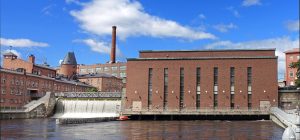Quick update on my spring course on “Energy and Literature”:
Today (13 March), I’ll take my students of the “Energy and Literature” course to visit the Tammerkoski hydroenergy plant (Tammerkoski keskikoski plant). Tampere has a rich industrial history. Located between two lakes, hydroenergy has been a important catalyst of energy transformations in the city, and the plant is still functioning today, in the very centre of the city. Very much looking forward to see local energy infrastructure, and to get a better sense of how historical energy solutions have had their impact on urban culture.

Last week (6 March), we discussed utopian possibilities in the energy humanities, and discussed “Sultana’s Dream“ (1905) by Debali Mookerjea-Leonard’s 2017 article “Futuristic Technologies and Purdah in the Feminist Utopia: Rokeya S. Hossain’s ‘Sultana’s Dream’”, published in Feminist Review. The key concept for the lecture was “utopia”, and the optional reading consisted of my own article on utopian cities, “Cities Utopian, Dystopian and Apocalyptic” (2016).
Please find below the questions for reading discussion I gave the students prior to the class:
What is the relation between human being, energy technology, and landscape / environment / society in Hussain’s text?
What forms of energy extraction, production, consumption, are described in Hussain’s text? How do they interact with human life and culture?
Consider our earlier definitions of Energy Humanities. Can this text be considered a useful resource within the EH – or not? Why?
How can this literary text be seen as a move towards a better society?
How can a study of this text be seen as a move towards a better society?
The text is – as always – culture-, language- and space-specific. What words in the text show this? What do they mean?
Consider Debali Mookerjea-Leonard’s article “futuristic technologies”. What does it add to our understanding of the text?
Within EH, there is a strong sense that energy transition has to mean also societal transitions towards a more just society. How does this fit in with Hussain’s text?
Optional question:
Consider the genre of utopia (see Ameel: ”Cities Utopian…”). To what extent does this text conform to the genre features of utopia? What does an analysis of utopia in the text add to our understanding of it?
